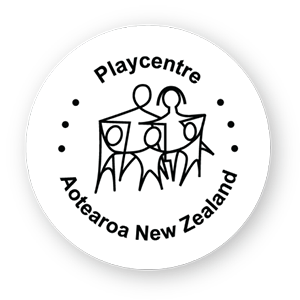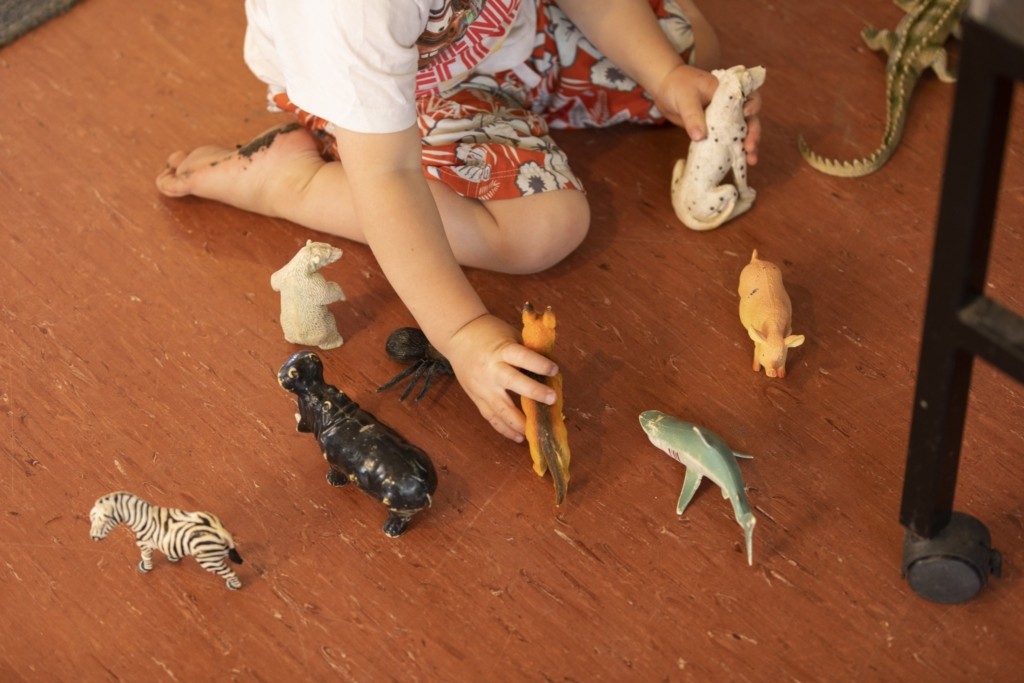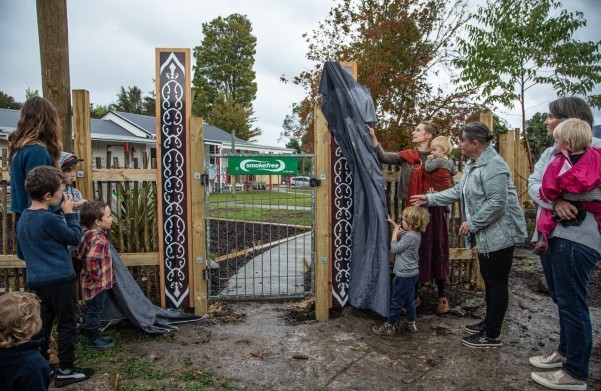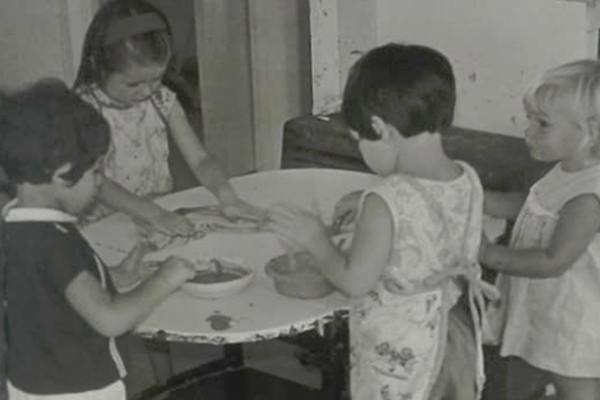This entry posted .
Unique to New Zealand (Aotearoa), Playcentre is a parent-led educational organisation providing adult and early childhood education since the 1940s. Founded on democratic principles embedded in the Progressive Education movement, Playcentre has evolved in response to the social changes in New Zealand society, in particular the changing role of women. As well as pioneering adult education publications and pedagogies, Playcentre was part of the normalisation of very young children in spaces designed for their learning through play.
Origins
The initial impetus for Playcentre was parent education. In the 1930s, Gwen Somerset’s regular sessions at Feilding Community Centre were designed for parents to learn about child development through observing their preschool children at play whilst being supervised by high school students enrolled in ‘mothercraft’. Active in the New Education Fellowship [NEF], Somerset had brought to New Zealand Progressive Education ideas as well as equipment, such as unit blocks. During World War II, the Fellowship’s network brought Somerset in contact with an existing initiative in Wellington started by three highly educated, confident and well-connected women – Beatrice Beeby, Joan Woods and Inge Smithells. They had established Nursery Play Centres to “provide leisure for mothers and opportunities for the social development of the pre-school child” (Stover, 1998b, p. 3). Their choice of name reflected a similar initiative begun in 1931 in England, which was focused on school age children. Hence the addition of the word ‘nursery’ indicated the focus was on younger children. Meanwhile, in Christchurch, Doreen Dolton, who had studied with Susan Isaacs of the NEF in London, was running a programme for parents and children.
In 1948, these three initiatives combined to form the New Zealand Nursery Play Centre Federation, electing Somerset as the first president, and amalgamating “two parallel concerns – the good of the child and the good of the parents” (Stover, 1998b, p. 3). Having a foundational focus on the education of both parents and children – Somerset thought that parent and child should enrol as one unit – has ensured an enduring tension as to Playcentre’s purpose. Having a democratic structure has set Playcentre apart from many educational organisations and made it both more open to societal change and more resistant to imposed change. In the context of twenty-first century New Zealand, Playcentre has had to reconsider what a commitment to democratic principles looks like in practice.
Rapid expansion
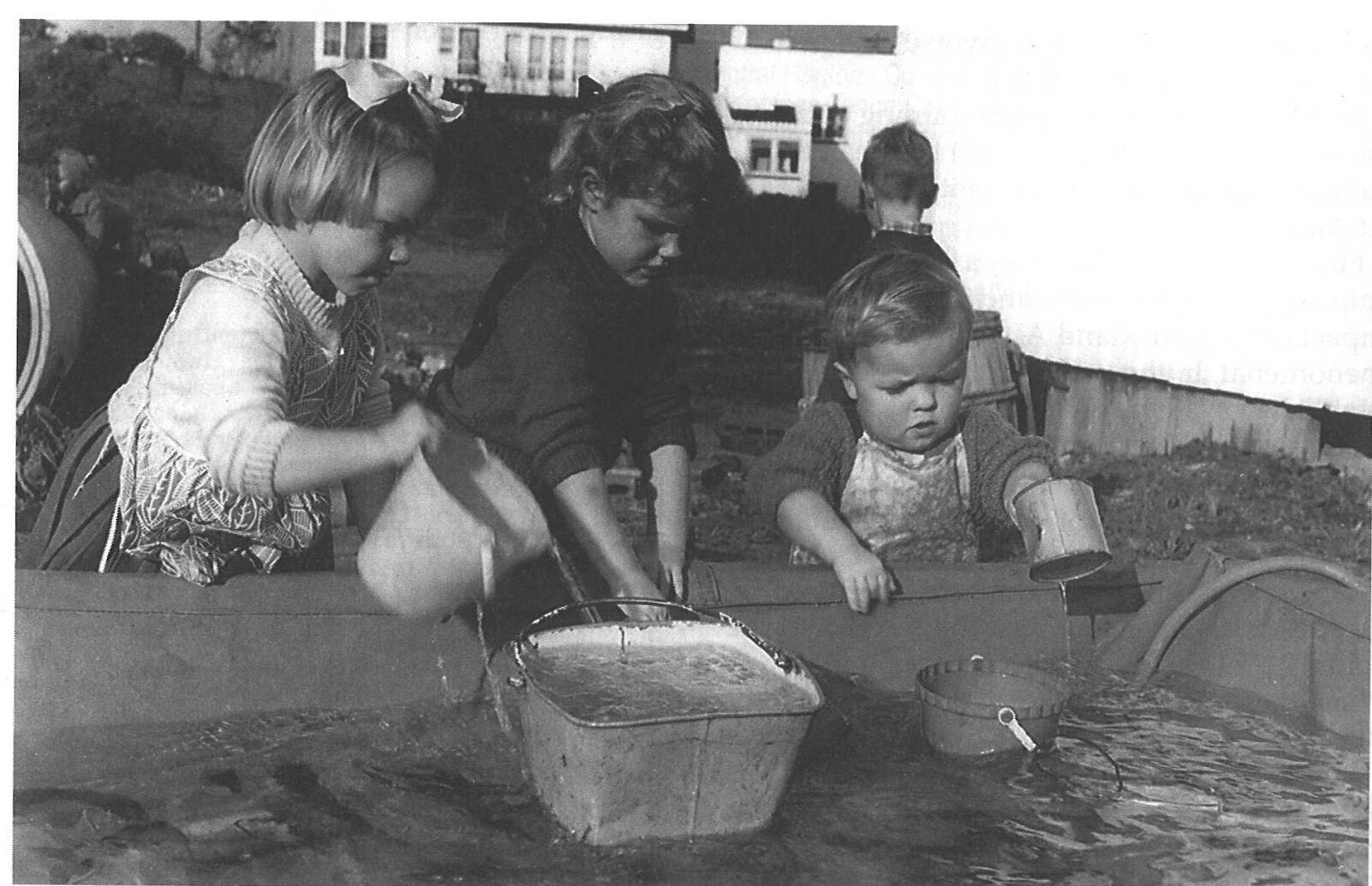
Rogan Street Playcentre, Auckland, in the 1950s. Photo from Good Clean Fun (Stover, 1998).
In the decades following the end of World War II, Playcentres flourished. This reflected the ‘baby boom’ and the subsequent demand for ‘preschools’ as well as concerns for the wellbeing of mothers, especially in new suburbs. Childcare was not very accessible, and with the rise of attachment theory in the 1950s and 1960s, it was seen as depriving children of sustained contact with their mothers. Preschool options for many women were therefore usually restricted to the sessional kindergartens and playcentres. Compared to the more professionally run kindergartens, Playcentres were relatively easy to establish as they were staffed and managed by parents and could use existing community facilities.
Adult education courses started in 1945 under the auspices of the Workers Education Association [WEA], with a strong emphasis on child development and the value of free play for young children’s learning.
These courses were designed both as general parenting education and as training for Playcentre Supervisors. Somerset was pivotal in creating national norms through her work as editor of the Playcentre Journal and through authoring numerous books and pamphlets explaining how children learn and develop through play.
Emphasising parent power
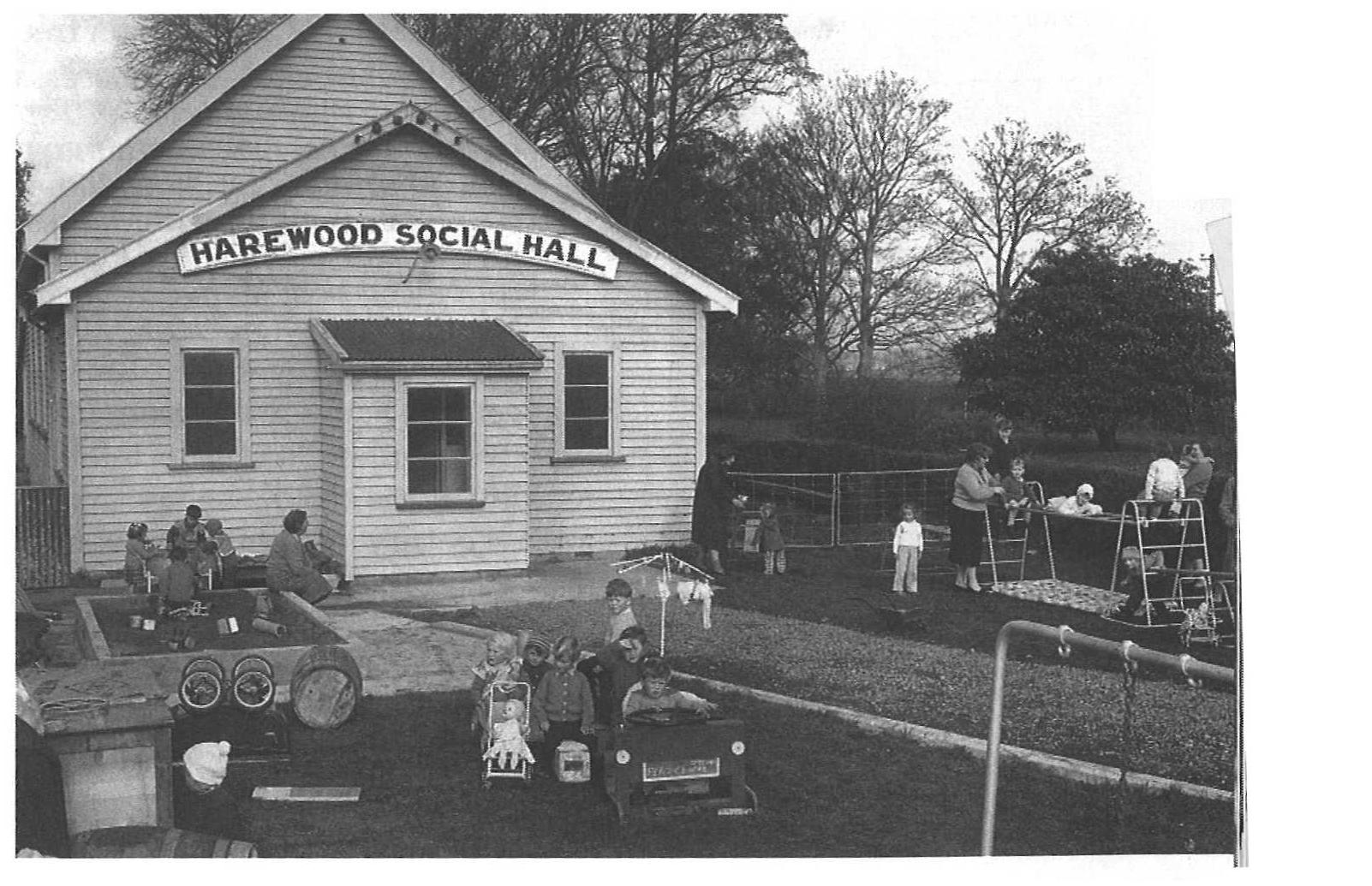
An early Playcentre set up in a community hall. Photo from Good Clean Fun (Stover, 1998)
A challenge to the dominant Playcentre model came in the 1960s in the form of Lex Grey, who was especially influential in the Auckland and northern regions. Rather than emphasising parents being supported by ‘experts’ as promoted by Somerset, Grey advocated for more fundamentally democratic practices and the systematic movement of power from established groups and individuals to newer group members (the philosophy of ‘emergent leadership’). He viewed parents as already capable and was outspoken with his belief that the parents in the local Playcentre should decide what was appropriate for their centre. By emphasising the importance of the ‘local’ in the face of ‘centralised’ standards Grey foregrounded the identity and culture of families and communities. Under his influence parents took more responsibility for their Playcentres, including collectively running sessions (‘group supervision’), managing the regional Playcentre Associations, and teaching the parent education courses – previously the domain of ‘experts’. This gave many women a socially-acceptable outlet for talents such as management and education, that might otherwise have been frustrated with the dominant perception of women’s role as located solely in the private sphere.
Women and children’s health benefited from Playcentre activism, with support for the Parents Centre’s campaign for babies to ‘room in’ with their mothers in the hospitals, and the opening of Playcentres in hospitals. These hospital Playcentres were forerunners of contemporary ‘play departments’ run by play specialists.
A social conscience
By the late 1960s, the generation known as the ‘baby boomers’ were instrumental in questioning ‘the system’; especially greater equity for marginalised groups which included women, Māori, and homosexual people. In this environment Playcentre continued to provide a support hub for young parents at a local level, as it had been doing for several decades, whilst the national Federation was a forum for expressing support for various social causes, often concerning the need for peace and nonviolence in society at all levels.
As the preschool advisor to the Māori Education Foundation, Grey worked with the Māori Women’s Welfare League to encourage Māori whānau to participate in early childhood education, and Playcentre with its family concept was often a good fit for them. In the 1980s, many of these predominantly Māori Playcentres choose to become ngā Kōhanga Reo. Like Playcentre, Kōhanga Reo was dedicated to the education and wellbeing of parents and children, but within the context of the revitalisation of the Māori culture through the immersion of its youngest members and their whānau in tikanga and te reo. For many Pākehā families, participation in Playcentre facilitated an awareness of Māori culture and issues that was not available to them through other parts of society, although the established structure maintained firm roots in Pākehā-style democratic practices.
Early childhood educational reform
Playcentre developed alongside Kindergarten as one of the two ‘mainstream’ ECE services that were acceptable to the government. The Bailey Report in 1947 and the Hill Report in 1971 both endorsed the view that young children were best cared for in the home by mothers, and that this was to be supported by institutions that offered half day, ‘educationally-based’ programmes (see May, 2009 for an explanation of these reports). Playcentre became known for its philosophies of free play, providing an environment with rich, varied and high quality equipment, adult education and promoting parents as the best educators of their children.
The election of a Labour Government in 1984, and again in 1987, heralded the introduction of major changes to New Zealand society. Inspired by neoliberal ideas which emphasised a free market economy, minimal government involvement in the economy and society, and consumer choice as a mechanism of accountability and quality assurance, these reforms fundamentally changed the face of national policy regarding the education of young children. Aligning these policy initiatives alongside social reforms – such as honouring indigenous rights embodied in the Treaty of Waitangi and feminist-driven initiatives to lift the status, quality and affordability of childcare – created a potent political agenda for change.
The government in 1988 embarked on a project of education administration reform with the Picot Report and subsequent policy document Tomorrow’s Schools. Early childhood education, already part of a Social Policy commission, became caught up in the reforms with the Meade Report and subsequent policy document Before Five. The effect of the Before Five universal framework of funding and administration was to create, through regulation, a united early childhood sector. In particular, childcare gained equal status with other early childhood services. A second strand to the Before Five reforms focused on improving the overall quality of early childhood services, through the introduction of minimum standards.
From 1989, Playcentre was a reluctant but fully included part of the united early childhood sector. Playcentre Federation officers participating in the reforms believed that Playcentre was not in need of change; as they saw it, the main purpose was to establish minimum standards which would raise the quality of childcare services. However the enforcement of the facilities requirements led to the closure of many Playcentres. Whereas it had been common to have ‘pack-away’ centres in community halls and other shared spaces, it was now necessary to have centres specifically designed to meet the regulations. Another drawback of the reforms for Playcentre was that although it had resulted in a substantial increase in funding, it also resulted in a correspondingly substantial increase in administration. However, Playcentre still had some political influence and used this to successfully advocate for an exception to be made to the specified requirement for the centre supervisor to hold a Diploma of Teaching, in favour of a team approach. Playcentre was placed in a category, along with Kōhanga Reo, that recognised that quality could result from ‘high parental involvement’.
The educational reforms also affected secondary and tertiary qualifications with the introduction of a new Qualifications framework and a new, separate agency to administer it. Playcentre registered as a tertiary education provider with the New Zealand Qualifications Authority in 1991. This necessitated a greater degree of standardisation of the adult education programme throughout the country as well as the introduction of a quality assurance system. It was more administration to add to the volunteers’ workload, along with the paid employment (often part time) that was becoming common for mothers. Instead of being an avenue for stimulating interaction, the volunteer work for Playcentre was becoming a stressful burden.
Becoming bicultural
While national standardisation has been a major challenge to Playcentre as a provider of both adult and early childhood education, commitment to social justice causes remained an equally important project. In 1989 a remit was passed at the annual conference which made a commitment to biculturalism and to recognising the Treaty of Waitangi. Work started immediately to make this aspiration a reality, with the publication in 1990 of Whānau tupu ngātahi: Families growing together, the title of which eventually became the Playcentre motto. Throughout the 1990s both Māori and Pākehā worked hard to understand themselves and their cultures, and to learn how to effectively dialogue with each other. Without guidelines or other histories to follow, it was very much trial and error, and much tension was generated with mistakes and misunderstandings. It is a significant task to change the attitudes of a large organisation with a high turnover of personnel. As knowledge of tikanga Māori and Te Tiriti o Waitangi became more widespread in Aotearoa New Zealand society in the 2000s, Playcentre was able to direct more energy into productive change rather than continually educating members on the basics of biculturalism. A significant milestone was reached in 2011 when Tiriti-based co-presidents of the Playcentre Federation were elected for the first time.
Children’s right to professional early childhood education?
The next two decades saw a number of initiatives that were aimed at increasing the quality of early childhood education, and concomitant with this, increasing the professionalization of early childhood education teachers. Playcentre contributed to sector developments such as the curriculum, Te Whāriki, and the Early Childhood Code of Ethics. Playcentre qualifications were still accepted in childcare centres, but there were targets for the number of early childhood education diploma-qualified teachers in centres. After colleges of education merged with universities in the 1990s, early childhood education diplomas slowly gave way to early childhood education degrees. In 2002 the government launched the 10-year Early Childhood Education Strategic Plan, which gave prominence to strategies designed to support ‘teacher-led’ services. Playcentre and Kōhanga Reo gained very little out of the Strategic Plan because of the difficulties in articulating specific policy strategies that would increase the quality in in ‘parent-led’ services. The government ECE Taskforce in 2011 further recommended that the government priority should be to support ‘teacher-led’ services, as they were the ones associated with quality early childhood education – a reversal of the 1990 position that recognised quality resulting from ‘high parent involvement’. While the Early Childhood Taskforce’s recommendations could yet become a blueprint for policy, they would likely cost government both politically (closures of Playcentres would be destabilising especially for many small communities) and financially (Playcentres is one of the least expensive forms of early childhood education.)
A further movement was the growing perception of early childhood education as a child’s right, because of the benefits that research showed accrued to the child through good quality early childhood education. The argument that universal early childhood education participation was a cost effective way to improve educational outcomes for all children was particularly persuasive. Since the Before Five reforms, policy has assumed, however that early childhood education occurs outside the home. Parents as educators of their own young children have become invisible in government educational policy.
The promotion of children’s right to early childhood education aligns nicely with workforce policy and with intensification of children’s institutional early learning (the 20 hours early childhood education policy sets a norm for hours per week in early childhood education). However the continued presence of Playcentre services troubles both alignments. Children in Playcentre implies parents with time to spend in their own communities, and those children will likely have the fewest average hours per week of early childhood education. This means that the education of Playcentre children reflects a wider learning space than just the regulated spaces designed for their education.
Importantly, the Playcentre Federation’s work on developing standard equipment lists for individual Playcentres helped to define and later to regulate the spaces for children’s learning through play. Arguably Playcentres have set the scene for the ‘educationalisation’ of play. However with its ongoing emphasis on parents-as-educators and its sessional provision, Playcentre are now troubling the normalisation of long day and commercial provision of early childhood education.
The future of Playcentre
The peak of enrolments in Playcentre occurred in the mid-1970s, and the number of enrolments has declined since, especially as childcare has become more accessible and affordable. Although there was been an overall increase in ECE enrolments since the Before Five reforms, the greatest growth has been in childcare, with a dramatic decline in enrolments in ‘parent-led’ services. Playcentre catered for 13,568 children in 447 centres in 2013 (accounting for 7% of all early childhood education enrolments that year); in 1970 it was estimated there were 17,109 children attending 592 centres (approximately 36% of all enrolments). It continues to be one of the least expensive forms of early childhood education, due to the input of volunteer labour.
Research commissioned in the mid-2000s affirmed the value of Playcentre in contributing to the social fabric of Aotearoa New Zealand society and presenting an alternative choice for those parents who wished to be actively involved in providing early childhood education for their young children, and also showed the time pressures to be some of the most urgent issues for Playcentre members. In response, Playcentre has spent time defining and articulating its philosophy to evaluate what is offered to new parents, reaffirming some basic principles: the value of parent involvement in their children’s education, the importance of play, the need for adult education and support alongside the children’s learning, and commitment to Te Tiriti o Waitangi. Structural changes in 2011 instigated a Tiriti-based framework for the organisation, and further structural changes to meet the stated aim of “more play, less admin” (including more employees to provide continuity of knowledge) are ongoing. In this way Playcentre intends to continue to meet the needs of a section of society which shares its priorities of creating teaching/learning opportunities for both parents and their very young children.
Glossary
Whānau – Extended family, usually seen as the smallest unit of Māori society
Māori – The indigenous people of Aotearoa New Zealand
Kōhanga Reo – A Māori early childhood and family education service, focusing on nurturing Māori culture and language
Pākehā – A non-Māori New Zealander (usually a person of European descent)
Te Tiriti o Waitangi – The Treaty of Waitangi, a treaty signed between many Māori chiefs and the British crown, on 6 February 1840
Tikanga – Culture, the ‘right’ way of doing things in the Māori world
Te Reo – The Māori language
Bibliography and References

